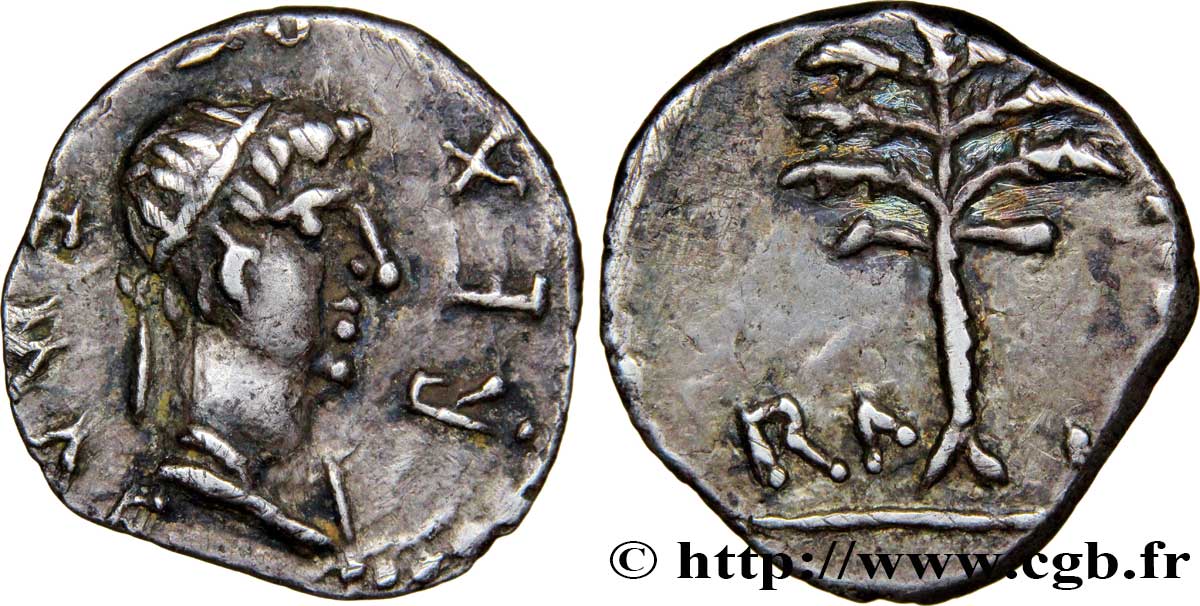v61_0046 - REGNO DI MAURETANIA - PTOLEMEO Denier
MONNAIES 61 (2014)
Prezzo di inizio : 750.00 €
Valutazione : 1 200.00 €
Prezzo realizzato : 790.00 €
Numero di offerte : 2
Offerta maxima : 800.00 €
Prezzo di inizio : 750.00 €
Valutazione : 1 200.00 €
Prezzo realizzato : 790.00 €
Numero di offerte : 2
Offerta maxima : 800.00 €
Tipo : Denier
Data: an 1
Nome della officina / città: Césarée, Maurétanie
Metallo : argento
Diametro : 14 mm
Asse di coniazione : 1 h.
Peso : 1,68 g.
Grado di rarità : R3
Commenti sullo stato di conservazione:
Exemplaire sur un petit ovale et irrégulier, court sur les légendes. Beau portrait de Ptolémée. Joli revers bien venu à la frappe. Belle patine de collection ancienne avec des reflets dorés
N° nelle opere di riferimento :
Diritto
Titolatura diritto : REX - [PTOLEMAEVS].
Descrittivo diritto : Buste diadémé et drapé de Ptolémée à droite, (A’01).
Traduzione diritto : “Rex Ptolemaeus”, (roi Ptolémée).
Rovescio
Titolatura rovescio : R A - I.
Descrittivo rovescio : Palmier.
Traduzione rovescio : (règne an 6).
Commento
Poids très léger. Normalement, Ptolémée a succédé à son père Juba Ier en 23. Mais en fait, il est associé aux affaires depuis 20 après J.-C. La datation des années régnales devrait donc se faire à partir de cette date. Ce type semble beaucoup plus rare que ne le laissent supposer les ouvrages généraux. Sur cet exemplaire l’année régnale est difficile à interpréter. C’est normalement l’an I (20-21) mais le flan est court et le type est aussi connu pour l’an 2 (A. 251).
Very light weight. Normally Ptolemy succeeded his father Juba I in 23. But in fact he has been associated with affairs since 20 AD. The dating of the regnal years should therefore be done from this date. This type seems much rarer than general works suggest. On this example the regnal year is difficult to interpret. It is normally the year I (20-21) but the flan is short and the type is also known for the year 2 (A. 251)
Very light weight. Normally Ptolemy succeeded his father Juba I in 23. But in fact he has been associated with affairs since 20 AD. The dating of the regnal years should therefore be done from this date. This type seems much rarer than general works suggest. On this example the regnal year is difficult to interpret. It is normally the year I (20-21) but the flan is short and the type is also known for the year 2 (A. 251)








 Segnalare un errore
Segnalare un errore Stampate la pagina
Stampate la pagina Condividi mia selezione
Condividi mia selezione Fai una domanda
Fai una domanda Consegnare / vendere
Consegnare / vendere





